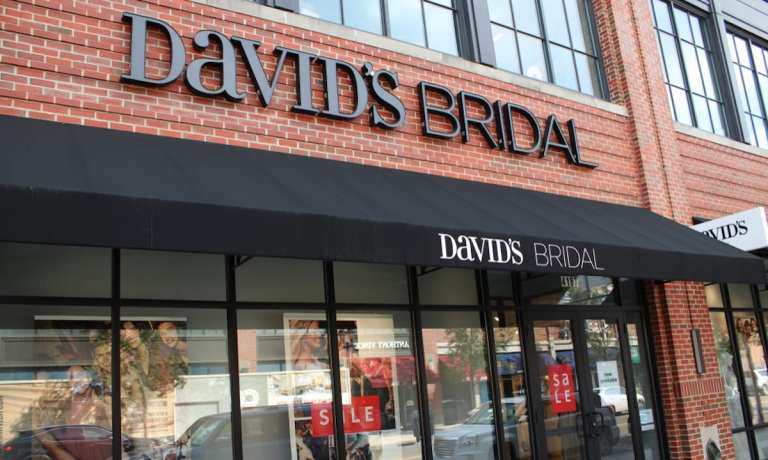David’s Bridal Loyalty Program Tops 500K Amidst Rebound In Weddings

When David’s Bridal started its inaugural loyalty program in December, it was the end of a tough year for the wedding industry. Countless brides had to downsize or postpone their nuptials because of COVID-19, and some retailers were left wondering when the market would return.
But now, seven months later, David’s has seen over 500,000 brides sign up for its Diamond Loyalty Program, which Chief Marketing and IT Officer Kelly Cook said has “pleasantly surprised” the company.
“We had faith in the program based on all of our research, but it has exceeded our expectations in just about every single metric we measure from a company perspective,” she told PYMNTS. Revenue is higher from members than nonmembers, return rates are lower and units per transactions are higher.
Brides who sign up for the Diamond Loyalty Program immediately unlock special offers from David’s and its partners. They also earn one diamond point for every dollar spent, which includes purchases of bridesmaids’ dresses and accessories. Family and friends of the bride can help her build points with any purchases they make at David’s Bridal, which can be communicated through a specialized wedding invitation insert.
Cook said one reason return rates may be lower for members of the Diamond Loyalty Program is because if an item is returned, so are the points, which sets the bride back on her road to a free honeymoon — the pinnacle of the available rewards at 5,000 points.
“I think it just causes them to pause a little bit on the return rate side to make sure they keep their points,” Cook said. “They probably have other avenues like gifting it to a friend or something of that nature, so they keep their points.”
Most brides who earn rewards are in the 3,000-point range, with a small subset reaching the 4,000-point reward level, but Cook said David’s Bridal has found that “once you hit four, you’re highly likely to get to five.”
“So it’s not a stair-step,” she said. “It’s pretty much either 3,000 points or 4,000 and 5,000 together.”
Growing the Program
In the coming months, Cook said David’s will introduce certain “enhancements” to the Diamond Loyalty Program, such as including purchases of tuxedos at Black Tux — one of David’s platinum partners — toward a free honeymoon.
“And that’ll really add up,” Cook said, noting that tuxedos for groomsmen and the groom will cost between $800 and $1,000 depending on the number of groomsmen — which is 20 percent of what’s needed to qualify for a free honeymoon before any purchases are made at David’s Bridal.
Other plans for the Diamond Loyalty Program follow David’s broader strategy as a company to offer “every dress in her closet,” Cook told PYMNTS, beyond just the bridal gown. David’s also has a selection of non-bridal products, such as girls’ night out and date-night dresses, as well as pantsuits and jumpsuits.
“We want to maintain that relationship even after the wedding is over,” Cook said. “Even if they didn’t earn a honeymoon, because the points don’t expire … she could end up earning the free getaway anyway, and she can still use it and take it even though it’s technically not a honeymoon.”
David’s has also seen interest in the Diamond Loyalty Program from mothers planning their daughters’ quinceañeras, with between 10 percent and 15 percent of members comprised of quinceañera moms trying to earn getaways for themselves.
David’s is also planning a strategic move in the event planning space that will impact the Diamond Loyalty Program, and vice versa, “in a gigantic way,” said Cook, though she declined to provide details. “We feel really good about the program and the rewards we’ve lined up,” she added.
Resurgence of Weddings
In 2019, prior to the pandemic, Cook said wedding budgets averaged around $17,000, but this year, they’re averaging $27,000 — and in the Northeast U.S., they’re even higher, reaching into the $30,000 and $40,000 range.
“There’s a lot of revenge spending and happiness spending going on, because … the world’s opened back up, so they’re having a little bit more fun with their weddings than they may have had in the prior times,” she noted.
Additionally, David’s has seen an interesting side effect from some of last year’s wedding postponements. When COVID-19 hit, David’s Bridal saw about 25 percent of brides downsize their wedding ceremony to a “minimony,” opting to have a bigger ceremony in 2021 when the pandemic subsided.
“What’s interesting is that some of the brides … are buying maternity bridal gowns because they decided to have a baby after they got married and before their big ceremony,” Cook said. “The maternity gown business is doing very, very well right now.”